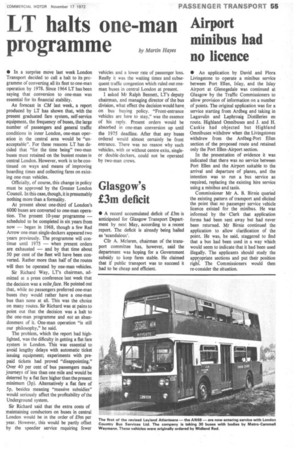• In a surprise move last week London Transport decided
Page 61

If you've noticed an error in this article please click here to report it so we can fix it.
to call a halt to its programme of converting all its fleet to one-man operation by 1978. Since 1964 LT has been saying that conversion to one-man was essential for its financial stability.
As forecast in CM last week, a report produced by LT has shown that, with the present graduated fare system, self-service equipment, the frequency of buses, the large number of passengers and general traffic conditions in inner London, one-man operation in the central area would be "unacceptable". For these reasons LT has decided that "for the time being" two-man buses must retained on the busiest routes in central London. However, work is to he continued on ways and means of improving boarding times and collecting fares on existing one-man vehicles.
Officially, of course, this change in policy must be approved by the Greater London Council. In this case, though, it is presumably nothing more than a formality.
At present about one-third of London's 6000 buses are converted to one-man operation. The present 10-year programme — scheduled to be completed in six years from now — began in 1968, though a few Red Arrow one-man single-deckers appeared two years previously. The programme will continue until 1975 — when present orders are exhausted — and by that time about 50 per cent of the fleet will have been converted. Rather more than half of the routes will then be operated by one-man vehicles.
Sir Richard Way, LT's chairman, admitted at a press conference last week that the decision was a volte face. He pointed out that, while no passengers preferred one-man buses they would rather have a one-man bus than none at all. This was the choice on many routes. Sir Richard was at pains to point out that the decision was a halt to the one-man programme and not an abandonment of it. One-man operation "is still our philosophy," he said.
The problem, which the report had highlighted, was the dificulty in getting a flat fare system in London. This was essential to avoid lengthy delays with automatic ticket issuing equipment; experiments with prepaid tickets had proved "disappointing." Over 40 per cent of bus passengers made journeys of less than one mile and would be deterred by a flat fare higher than the present minimum (3p). Alternatively a flat fare of Sp, besides meaning "massive subsidies" would seriously affect the profitability of the Underground system.
Sir Richard said that the extra costs of maintaining conductors on buses in central London would be in the order of £9m per year. However, this would be partly offset by the speedier service requiring fewer vehicles and a lower rate of passenger loss. Really it was the waiting times and subsequent traffic congestion which ruled out oneman buses in central London at present.
I asked Mr Ralph Bennett, LT's deputy chairman, and managing director of the bus division, what effect the decision would have on bus buying policy. "Front-entrance vehicles are here to stay," was the essence of his reply. Present orders would be absorbed in one-man conversion up until the 1975 deadline. After that any buses ordered would almost certainly be front entrance. There was no reason why such vehicles, with or without centre exits, singleor double-deckers, could not he operated by two-man crews.
































































































































































